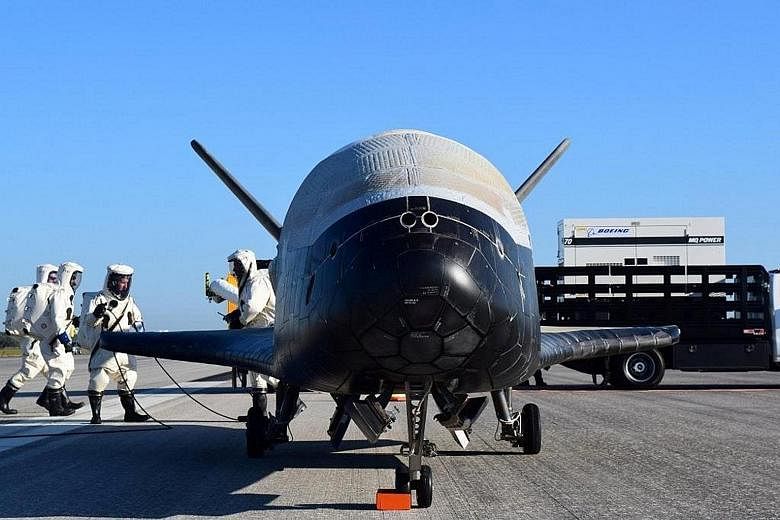WASHINGTON • After a nearly two- year sojourn in space, the US military drone X-37B is back on Earth, fuelling wild ideas about its mystery mission.
Looking like a small version of an old National Aeronautics and Space Administration (Nasa) space shuttle, the craft touched down on Sunday in Florida, ending a 718-day voyage around the Earth, the United States Air Force announced.
Just under 9m in length and with a nearly 4.6m-long wingspan, the X-37B was blasted into low Earth orbit atop a rocket.
Since its first flight in 2010, it has sparked all kinds of speculation about its real purpose.
Some think it might be a space- based bomber that could strike objectives on Earth at a moment's notice. Others suspect it is a potential "killer satellite", capable of destroying or damaging enemy satellites.
Or perhaps it is a super spy plane, orbiting Earth to keep watch on enemy territory as needed.
Fear that the world is on the brink of an arms race in space is behind some of those theories.
Satellites are crucial to the functioning of national economies as well as military operations, and the US, China and Russia are all thinking about ways to defend them against attack. No doubt they are also looking at ways to attack their adversaries' satellites.
In 2015, the mysterious behaviour of a Russian satellite fuelled speculation that Moscow was developing attack satellites capable of manoeuvring in space to zero in on other satellites.
But many experts doubt that the X-37B is the prototype for a true weapon of war or espionage.
"The X-37 is the size of a pickup truck - it would be difficult to have an effective weapon on board," said Ms Victoria Samson, an expert from the Secure World Foundation, an advocate of sustainable development in space.
Physicist Mark Gubrud, an expert on military space technologies at the University of North Carolina, said the idea of the drone as a manoeuvrable spy satellite does not make much sense either.
"If you want to make a stealthy, manoeuvring satellite, you will not weigh it down with wings and landing gear and make it so visible from Earth that even amateurs are able to track it," he said.
The X-37B's fourth flight was spotted six days after its launch in 2015 by a network of amateur satellite trackers, according to the website Spaceflight101.com.
It disappeared for several months in 2015 following a change in orbit, and again this February after another manoeuvre, but was later found again, the website said.
In reality, experts think the X-37B is more likely a test bed, just as the US Air Force said it was in one of its few public statements about the system. Experts think it is being used to test sensors and equipment in space that can then be brought to the ground to see how they have performed.
US company Rocketdyne announced that on the X-37B's latest flight, it tested an ionic thruster used by satellites to move in space.
"If the US military wanted to quell concerns, they could," by putting out more information about the X-37 B, said Ms Samson. "Maybe it's in their interest to keep people guessing."
AGENCE FRANCE-PRESSE

